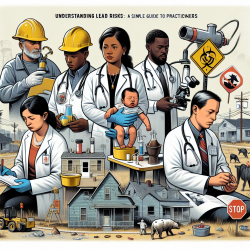Introduction
In the realm of public health, vaccine hesitancy poses a significant challenge, particularly concerning the Human Papillomavirus (HPV) vaccine. A recent study titled "HPV-Vaccine Hesitancy in Colombia: A Mixed-Methods Study" provides valuable insights into the factors contributing to this hesitancy among young females and their families in Colombia. This blog aims to translate these findings into actionable strategies for practitioners, particularly those involved in speech language pathology and related fields, to enhance vaccine uptake and improve health outcomes.
Understanding the Study
The study employed a convergent mixed-methods design, integrating quantitative and qualitative data to explore the behavioral components of HPV-vaccine hesitancy. Utilizing the capability-opportunity-motivation-behavior (COM-B) model, the research identified several factors influencing vaccine hesitancy, including lack of information, concerns about vaccine safety, and misconceptions about the relationship between HPV and sexuality.
Key Findings and Implications
Lack of Information
The study revealed that a significant portion of parents had not received adequate information about the HPV vaccine. This gap in knowledge is a critical barrier to vaccine uptake. Practitioners can play a pivotal role in bridging this gap by providing clear, evidence-based information about the vaccine's safety and efficacy.
Trust in Medical Recommendations
Trust in healthcare providers emerged as a crucial factor in vaccine acceptance. Practitioners should leverage this trust by actively engaging with families, addressing their concerns, and providing personalized recommendations. This approach can significantly enhance vaccine confidence and uptake.
Addressing Misconceptions
The association of HPV with sexuality was identified as a barrier to vaccination. Practitioners should address these misconceptions by framing the vaccine as a preventive measure against cervical cancer, rather than focusing on its association with sexual activity. This reframing can help mitigate parental concerns and promote vaccine acceptance.
Actionable Strategies for Practitioners
- Educational Interventions: Develop and implement educational programs that provide comprehensive information about HPV and the benefits of vaccination. These programs should be tailored to address specific concerns and misconceptions identified in the study.
- Community Engagement: Engage with community leaders and organizations to promote vaccine awareness and acceptance. Collaborative efforts can amplify the reach and impact of educational initiatives.
- Utilize Technology: Leverage digital platforms to disseminate information and engage with families. Online resources and virtual consultations can provide accessible and convenient avenues for information sharing.
- Collaborate with Schools: Partner with educational institutions to integrate vaccine education into school curricula. Schools can serve as effective platforms for reaching students and their families.
Conclusion
The findings from the "HPV-Vaccine Hesitancy in Colombia: A Mixed-Methods Study" underscore the importance of targeted interventions to address vaccine hesitancy. By implementing the strategies outlined above, practitioners can play a crucial role in enhancing vaccine uptake and improving health outcomes for children and adolescents.
To read the original research paper, please follow this link: HPV-Vaccine Hesitancy in Colombia: A Mixed-Methods Study.










